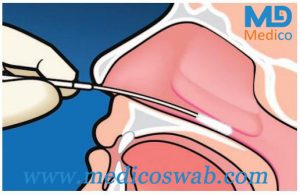Il s'agit d'une procédure clinique courante pour collecter des échantillons de surface de muqueuse respiratoire avec un tampon nasopharyngéal, qui est utilisé pour évaluer s'il existe un virus respiratoire ou des infections bactériennes chez les adultes et les enfants. Dans le diagnostic d'une nouvelle infection au coronavirus, La collecte d'écouvillon nasopharyngée pour la détection d'acide nucléique est une méthode d'examen importante. Les patients sans contre-indications spéciales de la collection de calibrage nasopharyngée peuvent être exploités. Si le patient a des antécédents récents de traumatisme nasal ou de chirurgie, ou a une histoire d'écart évident du septum nasal, ou a des antécédents d'obstruction nasale chronique et de trouble de coagulation sévère, Les cliniciens devraient être prudents.

Un écouvillon nasal pourrait aider à diagnostiquer le cancer du poumon
Opération
1.Tous les patients subissant de nouveaux tests de coronavirus devraient porter des masques, et le personnel de collecte doit fournir une protection personnelle appropriée au besoin.
2.Avant de collecter des spécimens, Demandez aux patients de retirer leurs masques et de se faire exploser le nez avec des serviettes en papier afin d'éliminer l'excès de sécrétions dans la cavité nasale.
3.Sortez l'écouvillon de l'emballage et inclinez légèrement la tête du patient en arrière, afin que l'écouvillon puisse atteindre le nasopharynx plus facilement à travers la cavité nasale. Dites au patient de fermer les yeux pour soulager un léger inconfort pendant l'opération.
4.Insérez doucement l'écouvillon de la gorge le long du septum nasal jusqu'à ce qu'un sentiment de résistance indique que l'écouvillon a atteint le fond du nasopharynx.
5.L'attention doit être accordée pour maintenir l'écouvillon de la gorge parallèle à la bouche pendant l'insertion. Si l'écouvillon rencontre une résistance lorsque vous traversez les passages nasaux, Il est nécessaire de retirer l'écouvillon et d'essayer de changer l'angle pour rentrer.
6.La profondeur d'insertion de l'écouvillon doit être égale à la distance de la narine à l'ouverture à l'extérieur de l'oreille. Les Centers for Disease Control and Prevention (CDC) recommande que l'écouvillon soit placé pendant plusieurs secondes après avoir atteint le bas du nasopharynx afin que le haut de l'écouvillon puisse absorber les sécrétions, puis le retirer lentement en faisant tourner l'écouvillon.















 Un écouvillon nasal pourrait aider à diagnostiquer le cancer du poumon
Un écouvillon nasal pourrait aider à diagnostiquer le cancer du poumon

